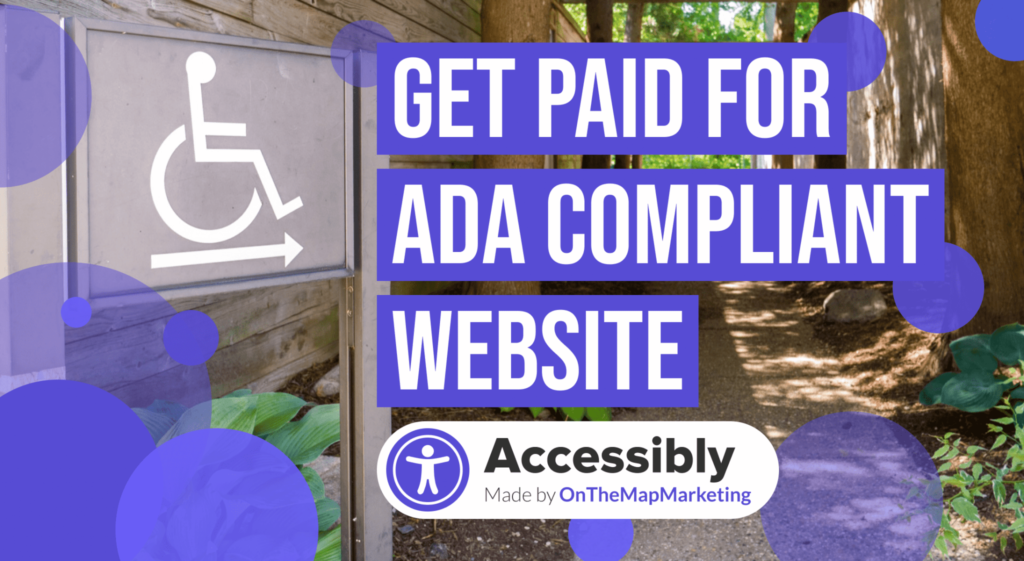
If you run a small business, you know that any tax deduction can be helpful. If your business has an online presence, you must make sure that it is ADA-compliant. Failure to do so could result in large fines and lengthy litigation.
ADA compliance online is imperative, though you’ll need to invest in the right measures to implement web accessibility. The ADA tax credit allows small businesses to recover some of the costs of this investment.
Over 96% of the world’s top web pages are not accessible, which means that they’re missing out on a huge segment of the market. They’re also vulnerable to lawsuits. If you want to be sure you’re ADA compliant, let Accessibly provide you with an accessibility widget that will help you avoid legal woes while enhancing your eligibility for the ADA tax credit.
Understanding the ADA Compliant Tax Credit
The ADA tax credit allows you to get up to $5,000 in tax credits to make your website accessible for people with disabilities. If you own a business, you may have made adjustments to be ADA compliant in the past. The Americans with Disabilities Act of 1990 prohibits discrimination against people with disabilities. While modifications were once limited to ramps and accessible bathroom facilities, the ADA now covers web accessibility.
While this may require major revisions to your existing platforms, there is good news: federal tax code allows for a tax credit for up to $5,000 on eligible access expenditures for small businesses.
There are a few requirements to be a small business eligible for the ADA tax credit. If you’re a firm earning less than $1 million per year in gross receipts from the previous year or have 30 or fewer employees working full-time, you may be eligible for an ADA tax credit for restructuring your premises, purchasing equipment, and website improvements.
This credit is offered through IRS Code Section 44. Businesses can claim the disabled tax credit by using the Disabled Access Credit Form, which can be used to purchase our plugin to apply website accessibility on your website for ADA compliance.
In 1998, the U.S. Congress expanded this provision of the Rehabilitation Act of 1973 to require any business that works with the federal government or receives funds from the federal government to make their electronic and information technology accessible to individuals with disabilities. Now, businesses are taking measures to ensure that they aren’t in violation, which could put their funding or contracts at risk.
This means that businesses are eligible for a 50 percent credit for expenditures over $250, not to exceed $10,250 (or $5,000) in total. The amount of this tax deduction can be subtracted from your tax liability. As with all matters concerning federal income taxes, you should consult your tax professional about what the ADA tax credit covers as well as other applicable tax deductions.
The ADA tax credit can only be used to reduce your costs of using adaptive equipment and improving accessibility. When your small business is ADA-compliant, you can receive a tax credit. You will need to determine your annual accessibility fee but there are factors that must be considered first. The website page adjustments, page structure editing, live chat support, and other features that make it more accessible are part of these considerations.
Fortunately, applying for the ADA tax credit is fairly simple. You will need to track your expenditures for the ADA-compliant items, which could mean you will be eligible to get some of your money back.
Importance of ADA Compliance
U.S. accessibility laws help to make access equitable for all people, including those with disabilities. The difference between ADA and WCAG involves bringing U.S. federal laws in line with the internationally recognized Web Content Accessibility Guidelines.
The guidelines highlight why accessibility is essential in today’s world. While the ADA tax credits will benefit your business, they also make all of your potential customers feel welcome. In the virtual world, it is the equivalent of making a ramp available to those who cannot use stairs.
An accessible website also shields you from lawsuits while providing inclusive measures. Even small businesses are drawn into litigious situations, which could cause serious problems.
One way to make sure you are following all requirements of the Americans with Disabilities Act is to download the Accessibly widget. It helps businesses create accessible websites and maintain accessible formats by following accessibility requirements mandated by federal courts.
How Accessibly Facilitates ADA Compliance
There is no need to have extensive tech knowledge to get started with Accessibly to improve the accessibility of your website. This simple widget works to make your site readable in a variety of ways for those with vision impairments.
Accessibly can help your website become accessible using enlarged content, adjustable colors for brightness and contrast, and incorporate screen readers for those with hearing impairments. It’s fast to install and supported by many platforms, making it easy to enhance your website for everyone’s benefit. The tax credit is merely a bonus you get for your business.
It’s incredibly simple to get started with Accessibly, and with the tax credit on qualified expenses to bring your website up to date with the codes, there’s no better time to get started than right now.
Unlocking the ADA Compliance Tax Credit with Accessibly
Accessibly’s accessibility widget can help you score tax benefits on your tax return in the next tax year. It is available for all platforms, allowing you to tap into tax incentives that ultimately benefit your business. The unused portion could even provide a credit amount to be used in the following tax year.
Enhance your total revenues by giving access to all through website updates. You can see the difference on your next tax return. Even better, you can get a free Accessibly trial to start being compliant today!
